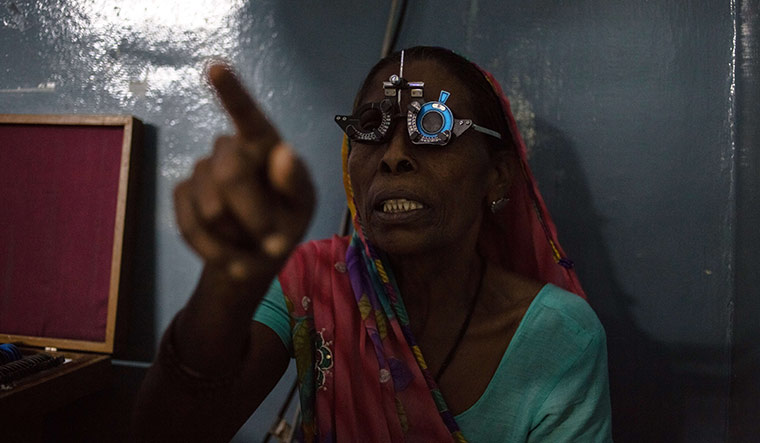Women who have salaried jobs experience slower decline in memory, which may reduce their risk of dementia and Alzheimer’s later in life.
For the US study presented at the Alzheimer’s Association International Conference, the researchers followed 6,836 women born between 1935 and 1956.
The women, who were in their 50s at the start of the study, provided information about their parental and marital status and employment history. They had memory assessment tests, which included memorising a series of words and recalling them later, every two years for about 20 years.
The group included working married mothers, working single mothers, stay-at-home married mothers and stay-at-home single mothers.
Some level of cognitive decline was seen in most women after the age of 60, which is natural. But memory declined at a faster rate in women who did not engage in paid work.
Married mothers who did not work had a 61 per cent faster memory decline compared to married mothers who had paying jobs.
Single mothers without paid work saw the fastest decline. Their memory declined 83 per cent faster compared to married mothers who worked.
Cancerous heartbreak
Broken heart syndrome is not just a trigger for heart events. According to an international study published in the Journal of the American Heart Association, one in six people with broken heart syndrome also had cancer. What is more, they were more likely to die within five years after the syndrome began.
Broken heart syndrome occurs when the heart’s main pumping chamber temporarily enlarges and does not pump properly. It can be triggered by emotional situations such as the death of a loved one, or by a surgery or physical trauma.
Of the 1,604 patients with broken heart syndrome included in the study, 267 patients had cancer. The average age was 69.5 years, and 87.6 per cent were women. The most common type of cancer was breast cancer. Other affected areas included the gastrointestinal system, respiratory tract, internal sex organs, and the skin.
Cancer patients were more likely to have physical triggers and less likely to have emotional triggers.
Blind about women's issue
Blindness in general, and blindness caused by cataracts in particular, are considerably higher among Indian women compared to Indian men. But women are less likely to have their cataracts corrected with surgery, finds an Indian study published in the British Journal of Ophthalmology.
To analyse the gender-related differences in blindness, cataract blindness and cataract surgery in India, the researchers reviewed 22 studies.
The age of the study participants ranged from 61 to 70.
Blindness was more prevalent among women (5.68 per cent) than in men (4.17 per cent).
Women were 35 per cent more likely to be blind and 69 per cent more likely to be cataract blind than men. But women were 27 per cent less likely to get cataract surgery compared to men.
Around 35 per cent of the prevalence of blindness and 33 per cent of the prevalence of cataract blindness in women can be attributed to their gender alone.
The researchers highlight several possible explanations for the gender difference in the prevalence of blindness in India.
Longer life expectancy and biological predisposition to age-related illnesses can only partly explain the gender differences.
Access to surgery could be a major contributing factor. Having less control over household income, inability to travel outside their village to access care, and lack of education or awareness make surgical correction less likely.
Pressure parameter
A study published in the New England Journal of Medicine shows that the diastolic blood pressure is also an important indicator of cardiovascular events.
The researchers reviewed more than 36 million blood pressure readings from 1.3 million people for the study.
According to new guidelines issued by the American College of Cardiology, a reading of 130/80 mmHg is considered as high blood pressure which is lower than the traditional threshold of 140/90 mmHg. A reading of 120/80 mmHg is considered normal.
Over eight years of follow up, more than 44,000 patients had a heart attack or stroke. The study found that while systolic blood pressure was a stronger predictor of heart attack and stroke, diastolic blood pressure also increased the risk.
On average, the risk of cardiovascular events rose by about 18 per cent with increase in each unit of systolic pressure above 140. Similarly, the risk increased by 6 per cent with increase in each unit of diastolic blood pressure above 90.
Did You Know?
Cognitively normal older adults with high levels of amyloid-ß protein, linked to Alzheimer's disease, in their brains can slow any mental decline if they socialise regularly.
American Journal of Geriatric Psychiatry
Age is not just a number
Foot morphology, or the shape of our feet, changes and foot deformities increase as we grow older. But older adults often wear ill-fitting shoes that can affect their balance and gait, and increase the risk of falls and fracture.
To find out the effects of footwear on comfort, mobility and quality of life among adults aged 65 and older, Dutch researchers reviewed 57 studies.
According to them, safe and comfortable footwear for older adults should include proper anatomical fit, a well-fitting toe box, a low heel height, a broad enough heel, a firm insole and midsole, an outsole with sufficient tread and width, a bevelled heel and shoe nose, a firm heel counter with snug fit, and an easy and effective closing mechanism.
The researchers found that when older adults were provided with properly fitted shoes, they experienced less pain, and higher quality of life related to foot health and general health.
Sugary cause for cancer
People who drink a lot of sugary drinks, including soda and juice, have an increased risk for various cancers, especially breast cancer.
The French study published in The BMJ included 101,257 healthy adults (21 per cent men and 79 per cent women) with an average age of 42 years.
Participants answered questions about their daily intake of 3,300 different foods and beverages. Men, on average, drank more sugary drinks than women.
During nine years of follow up, 2,193 cases of cancer were diagnosed. The average age at diagnosis was 59 years.
Drinking 100ml of sugary drinks each day was associated with an 18 per cent increased risk of overall cancer and a 22 per cent increased risk of breast cancer, even after accounting for well known risk factors for cancer, such as age, sex, education, family history, smoking and physical activity.
All sugary drinks, including 100 per cent fruit juice were associated with a higher risk of overall cancer. However, artificially sweetened beverages were not associated with a risk of cancer.
Did You Know?
Genetic factors account for 80 per cent of autism spectrum disorders. Environmental causes are responsible for the remaining 20 per cent. Maternal factors such as a mother's diet and weight, and mode or timing of delivery were almost nonexistent.
JAMA Psychiatry
Can dementia be prevented?
According to a British study published in the Journal of the American Medical Association, following a healthy lifestyle can lower your risk of dementia even if you have a high genetic risk.
The study included 196,383 adults, aged 60 and older, without dementia at the onset.
Based on their genetic predisposition, the participants were grouped as high, intermediate and low genetic risk for dementia. They were also grouped on the basis of favourable, intermediate and unfavourable lifestyles they follow.
There were 1,769 cases of dementia during eight years of follow-up. Both genetic risk and healthy lifestyle were independently associated with risk of dementia.
The risk of dementia was 32 per cent lower in people with a high genetic risk if they had followed a healthy lifestyle, compared to those who had an unhealthy lifestyle. Participants with high genetic risk and an unhealthy lifestyle were almost three times more likely to develop dementia, compared to those with a low genetic risk and healthy lifestyle.
Early indicators
People with high blood pressure or high cholesterol before age 40 are at an increased risk for cardiovascular diseases later in life.
The study published in the Journal of the American College of Cardiology included data from six studies involving 36,030 participants aged 18 to 84.
The researchers looked at the association between blood pressure readings and cholesterol levels during early adulthood (18 to 39 years) and later adulthood (above 40), and subsequent risks of coronary heart disease, heart failure and stroke.
During 17 years of follow up, 4,570 people had coronary heart disease, 5,119 had heart failure and 2,862 people suffered a stroke.
People whose LDL (bad) cholesterol was 100mg/dL and up before age 40 had a 64 per cent higher risk of coronary heart disease compared to people with low LDL levels in early adulthood.
Young adults with a systolic blood pressure (top number) reading above 130 had a 37 per cent elevated risk for heart failure later in life compared with someone with a reading under 120. And those with a diastolic blood pressure (bottom number) reading above 80 had a 21 per cent greater risk compared to someone with a reading under 80.
Did You Know?
Having access to a garden, or being able to see green spaces from your home can reduce cravings for alcohol, cigarettes, and unhealthy food.
Health & Place
Every minute matters
Starting treatment for stroke patients 15 minutes sooner can save lives and prevent long term disability, according to a study published in JAMA.
To analyse patient outcomes based on their 'door-to-puncture' time—the interval from their arrival at the hospital to the time their treatment began—the researchers reviewed data for 6,756 patients who suffered ischaemic strokes and were treated with endovascular reperfusion therapy. The average age of the patients was 69.5 years, and 51.2 per cent were women.
For every 1,000 patients whose time to treatment was 15 minutes sooner, 15 fewer died or required hospice care after discharge from the hospital, 17 more were able to walk out of the hospital without support and 22 more could care for themselves after leaving the hospital.
The study found that the median time from arrival at the hospital to the start of treatment was 1 hour 27 minutes, and the median time from the start of stroke symptoms to treatment was 3 hours 50 minutes.
The study also found that treatment initiation tends to be delayed in hospitals that treat less than 30 stroke patients each year and at hospitals that are not certified as comprehensive stroke centres.
Microvascular risk
Microvascular disease, or small vessel disease, can increase the risk of leg amputations, irrespective of its location in the body.
For the study published in the journal Circulation, the researchers looked at the risk of amputation among 125,674 veterans with microvascular disease, peripheral artery disease (PAD) or both.
PAD is a narrowing of the arteries typically found in the legs. Left untreated, PAD can lead to gangrene and amputation.
There were a total of 1,185 amputations during an average of nine years of follow up.
Those with microvascular disease had a 3.7 times greater risk of lower limb amputation, and accounted for 18 per cent of all amputations.
Those with PAD had a 13.9 times greater risk of lower limb amputation and accounted for 22 per cent of all amputations.
Participants with both microvascular disease and PAD had a 23-fold increased risk of lower limb amputation and accounted for 45 per cent of all amputations.
Did You Know?
You are more likely to meet your weekly exercise goals if you exercise at the same time every day.
Obesity
Small cut, big impact
Cutting just 300 calories from your daily diet can significantly improve cardio-metabolic risk factors, and reduce the risk of cardiovascular diseases and related deaths.
The study published in the journal The Lancet Diabetes & Endocrinology included 218 healthy, non-obese adults aged 21 to 50.
Among them, 143 participants were assigned to a calorie-restricted diet. They had to reduce their daily calorie intake by 25 per cent for two years, while the remaining participants continued their usual diet.
The ability to cut calories varied among the participants in the calorie-restricted group. The average calorie reduction was about 12 per cent over two years.
Even with 12 per cent calorie retraction, which equals about 300 calories, they lost 10 per cent of their body weight, 71 per cent of which was fat.
They also had lower levels of a biomarker that indicates chronic inflammation, which has been linked to heart disease, cancer and cognitive decline.
CONTRIBUTOR: SHYLA JOVITHA ABRAHAM









